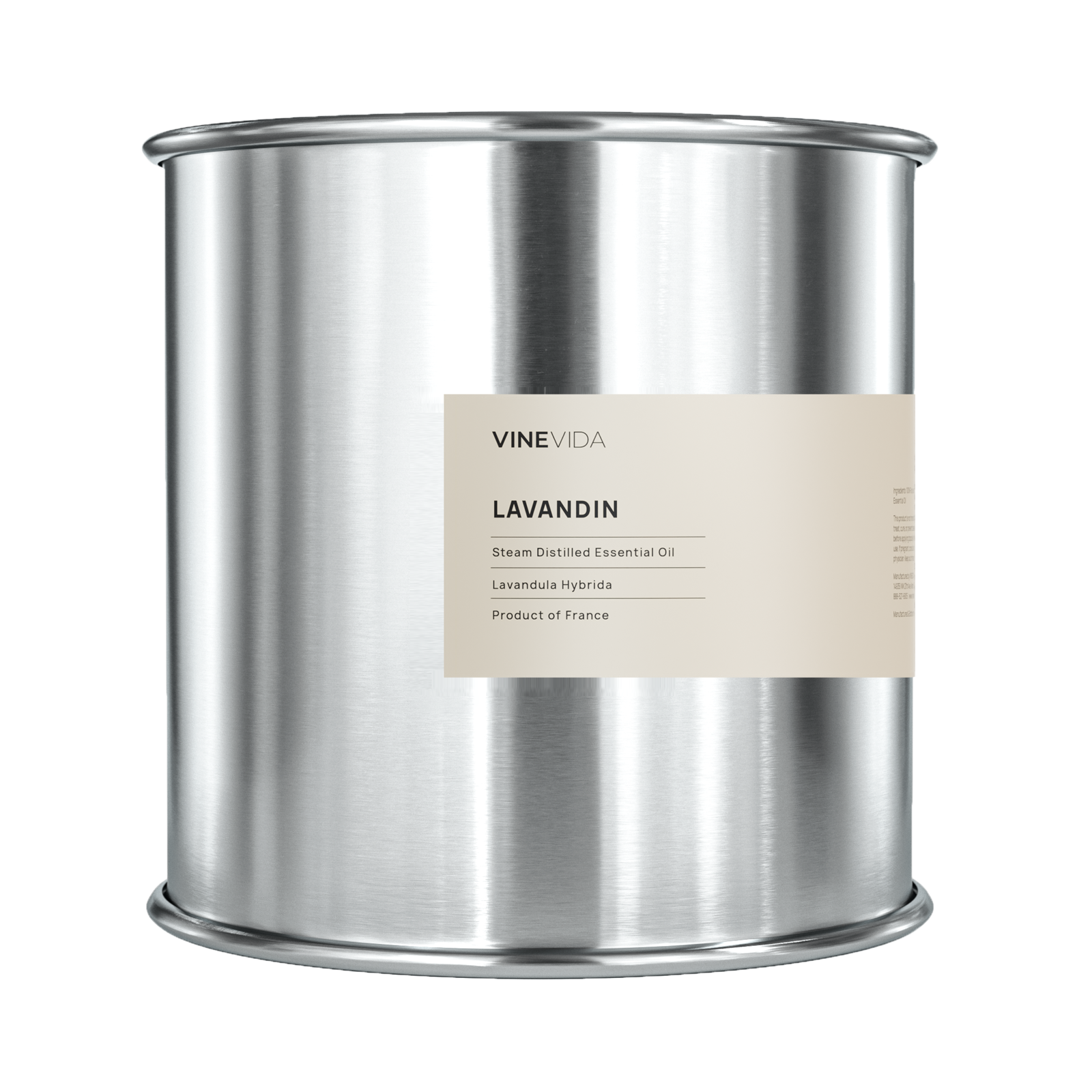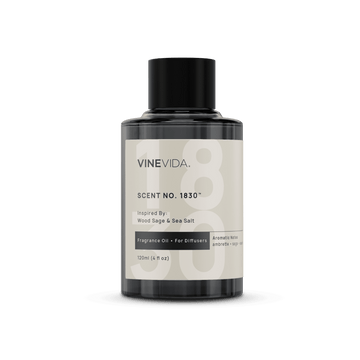Scientific Name: Lavandula Hybrida
Origin: France
Plant Part: Flowers
Scent: Herbal, Fresh, and Floral
Color: Clear to Pale Yellow
Consistency: Thin
Perfumery Note: Top - Middle
Initial Aroma Strength: Medium
Extraction Method: Steam Distilled
Lavandin Essential Oil: Benefits, Uses, and Blends
Move over lavender! It’s time for Lavandin Essential Oil to step out onto the center stage. Belonging to the same genus as Lavender, Lavandin Oil offers a stronger, more herbaceous aroma than its cousin. Read on to discover how Lavandin Oil offers many of the same benefits as Lavender, but with a stronger fragrance throw making it a great choice for candles and incense.
When it comes to classification systems, plants are broken down into three categories. The broadest category is family, then genus, and finally species. Both Lavandin and Lavender fall under the Lamiaceae family. Interestingly enough, the Lamiaceae family is also known as the mint family! The Lavender genus is Lavandula, and there are over 45 different species, all of which are native to the Mediterranean and the Middle East. The most common species of Lavender in essential oils are Lavandula Angustifolia, and Lavandula X Intermedia, or Lavandula Hybrida as it’s also known. The latter is the species that we use to create Lavandin Essential Oil.
Lavandin vs. Lavender Essential Oil
Lavandin Oil comes from the Lavandula Hybrida, which, as the name indicates, is a hybrid of two species of Lavender. These two species are Lavandula Angustifolia and Lavandula Latifolia, which is also known as “Spike Lavender”. It is important to note that hybrids are not genetically modified. They naturally occur in nature when one plant pollinates another growing nearby.
Lavandin is the least expensive of the two, as the Lavandin plant yields more oil than the Lavandula Angustifolia. It also has a much higher percentage of camphor, which we will now go on to discuss in more detail.
Lavandin Essential Oil Benefits: Component Breakdown
- Linalool: A terpene known for its floral, fragrant aroma, linalool is also a natural pesticide. It is on the US EPA list as a pesticide, with the classification of “practically non-toxic” for air inhalation, and “slightly toxic” for topical or oral use.
- Linalyl Acetate: This component is the acetate ester of linalool. It is clear, odorless, and common in fragrances, as well as soaps and detergents. This component contributes to Lavandin Essential Oil benefits to a great extent.
- Camphor: Camphor is a common terpene. It is a key ingredient in many creams, lotions, and ointments, and shows antibacterial and antifungal properties. Studies also indicate it has an anti-aging effect, including the ability to increase the production of collagen. Camphor is likely most famous for its ability to help reduce symptoms of cold and flu, aiding in the reduction of coughing and congestion. It is found in over-the-counter medications such as Tiger Balm, Bengay, Icy Hot, and Vicks.
- Terpinen-4-ol: Research indicates terpinen-4-ol may be capable of cancer cell destruction, both on its own and in combination with other treatments.
- 1,8-Cineole: More commonly known as eucalyptol, cineol is a natural monoterpene. Evidence indicates it to be both an anti-inflammatory and an antioxidant. Furthermore, cineole shows signs of being able to cross the blood-brain barrier, which means it may be of use as a carrier. Scientists consider cineol a potentially important component in the ability to combat chronic disease, though more research is necessary. Along with many other oils, 1,8-Cineole has a huge impact on Lavandin essential oil benefits as well.
Lavandin Essential Oil Uses: For Wholesale Purposes
Lavender has been around for many years. Records dating back to 77AD show the Greeks using lavender in herbal medicines, and it was a favorite of both the Romans and Egyptians for bathing and incense. Over the years it has become famous for its calming properties, and its ability to help improve sleeping patterns. Lavender is also a common additive to soaps and cosmetics, due to its mild floral fragrance. Let’s take a closer look at Lavandin Essential Oil and some of its various uses.
Cleaning Products
The cleaning product is one of the many uses of Lavandin Essential Oil. Natural cleaning products are becoming more and more popular, as the demand for chemical-free products increases. As people become aware of not only what toxins are in their everyday products, but how they affect the environment, they are increasingly going organic. These “clean” products often don’t contain any fragrance, which can make them a little lackluster. Essential oils are a safe and natural way to add fragrance to products. Lavandin oil with its sweet, herbaceous scent is a great alternative to lavender oil due to its stronger fragrance.
Candles
Lavandin essential oil used for candles is significant as it adds a great fragrance to them. This is because it tends to have a stronger scent than traditional lavender, allowing it to throw further. If you haven’t already checked out our blog article on DIY candle making, take a look and see how easy it can be to make safe, natural, candles!
Clear Congestion
Lavandin essential oil is much higher in camphor than lavender. Camphor is a common ingredient in many over-the-counter products including Vicks, Benadryl, and Tiger Balm. It is known to reduce coughing and congestion and works best through steam inhalation.
Massage Therapy
Many anecdotal claims adding lavandin to massage oils may help relax the body. While there is no factual evidence to back this up, there is no denying massage is a great tool for beating stress. Studies show patients with certain chronic diseases can benefit from aromatherapy in addition to conventional medicine. This is because most chronic diseases are rooted in oxidative stress and inflammation. Being both an antioxidant and anti-inflammatory means Lavandin may be beneficial in these situations. Adding essential oils to massage oils (never apply directly to the skin) is a great way to incorporate Lavandin Oil into your routine.
Soap Making

Many soaps you will find in shops and stores contain potentially harmful chemicals, many of which can be absorbed through the skin. The demand for natural soaps is rising as consumers begin to place more value on safe, clean products: forecasts looking at the essential oil soap market predict a global value of around USD $458.6 million by 2026. At VINEVIDA we are proud supporters of businesses that create products with all-natural ingredients, particularly essential oil soaps!
Lavandin Essential Oil: Popular Blends
The scent of lavender is one of the most popular aromas out there, and there are many possible blending combinations. In fragrance terms, Lavandin is somewhere between being a middle and being a top note. Essential oils that blend particularly well with Lavandin include Frankincense, Cedarwood, Cinnamon, Lemon, Rosemary, and Lemongrass.
Lavandin Essential Oil: DIY Around The House
Now let’s talk a little about how to use Lavandin Oil at home!
Lavandin Essential Oil is a great ingredient for room-freshening sprays. Similar to cleaning products and candles, commercial room sprays can contain many toxic chemicals. The solution to this is to make your own! That way you will know exactly what it contains, alongside the added benefit of being able to simply refill the bottle when needed rather than throwing out more plastic. All you need is a glass amber bottle, to prevent the oxidation of your oils. Feel free to get creative and make up your combinations.
Summer Spray
-
- 3/4 cup of water
- 2 tbsp Vanilla extract (Vanilla Planifolia)
- 6 drops of Lavandin Essential Oil (Lavandula Hybrida)
- 5 drops of Ylang-Ylang Essential Oil (Cananga Odorata)
- 5 drops of Grapefruit Essential Oil (Citrus Paradisii)
Is Lavandin Essential Oil Safe For Dogs?
Yes and no. Many websites suggest the use of Lavender Essential Oil to help calm and soothe restless pets. First off, your pet should never ingest essential oils. Lavender contains linalool which is toxic to cats and dogs. However, some studies show indications that Lavandin Oil can help lower levels of anxiety in dogs. The best method of using essential oils around pets is the passive diffusing method. This includes oil diffusers, heat diffusers, and reeds, or sticks. Open the bottle a few feet away from your pet and watch his or her reaction. If they run away, sneeze, rub their face, or show other signs of distress, likely, they will likely not enjoy the scent. If your pet simply seems curious, then try using the passive diffuser, ensuring you give them a way out of the room if it becomes too much for them.
Read More: Oil safe for dogs.
Is Lavandin Oil Safe For Cats?
When it comes to cats, our feline friends are a little more tricky. They lack an enzyme required to metabolize certain compounds in essential oils, making them particularly susceptible. Using an active diffuser will dispel droplets into the air. If these droplets make their way onto your cat's coat, he or she may lick them off while grooming, which puts them at risk. If your cat does come into contact with oils the best thing to do is to get as much off as possible. Thoroughly bathe them, and then closely monitor them for the next few days. Drooling, sneezing, coughing, wheezing, and watery eyes are all signs which should not be ignored.
Precautions
Never ingest essential oils, or apply them directly to the skin.
Lavandin Essential Oil along with all other oils is very potent and can cause injury or illness if not used with caution. If you have any underlying conditions we advise seeking the opinion of a medical professional before adding any sort of adjunct treatment. Always dilute oils with carrier oil before applying topically, and do a test patch first.
Why Choose VINEVIDA
At VINEVIDA, we are strong believers in transparency. Our oils are all 100% natural, and we provide all customers with GC-MS, COA, and SDS to ensure it. We also put a focus on educating our customers, so they have the knowledge to use essential oils both responsibly and sustainably. VINEVIDA offers competitive wholesale pricing and guarantees every order will ship with premium, durable packaging.
Flash Point
75° C
Conclusion
We hope you now feel confident choosing between Lavandin vs. Lavender Essential Oil and have a better idea of which suits your needs. At VINEVIDA we are proud to provide competitive pricing for our wholesale consumers. Contact us today to find out how we can help you!
You may also like
Recently viewed















 IFRA Statement
IFRA Statement



















